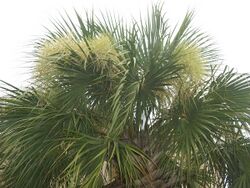Biology:Coryphoideae
| Coryphoideae | |
|---|---|

| |
| Sabal palmetto | |
| Scientific classification | |
| Kingdom: | Plantae |
| Clade: | Tracheophytes |
| Clade: | Angiosperms |
| Clade: | Monocots |
| Clade: | Commelinids |
| Order: | Arecales |
| Family: | Arecaceae |
| Subfamily: | Coryphoideae Burnett[1] |
| Tribes | |
|
Borasseae | |
The Coryphoideae is one of five subfamilies in the palm family, Arecaceae.[2][3][4] It contains all of the genera with palmate leaves, excepting Mauritia, Mauritiella and Lepidocaryum, all of subfamily Calamoideae, tribe Lepidocaryeae, subtribe Mauritiinae.[5][4][3] However, all Coryphoid palm leaves have induplicate (V-shaped) leaf folds (excepting Guihaia), while Calamoid palms have reduplicate (inverted V-shaped) leaf folds.[4] Pinnate leaves do occur in Coryphoideae, in Phoenix, Arenga, Wallichia and bipinnate in Caryota.
Classification
Subfamily Coryphoideae is divided into 8 tribes:[3]
The genus Sabinaria was discovered and described after the classification used here[3][4] was published, but its morphology clearly places it in tribe Cryosophileae.[6] The genus Saribus was split from Livistona,[7] while Lanonia was split from Licuala,[8] also after publication. Tribe Trachycarpeae was initially described as tribe 'Livistoneae',[3] but the name Trachycarpeae has priority.[4]
Also Uhlia is an extinct genus described from permineralized remains recovered from the Ypresian Princeton Chert in British Columbia, Canada.[9]
References
- ↑ Dowe, John Leslie (2010). Australian Palms: Biogeography, Ecology and Systematics. CSIRO Publishing. p. 87. ISBN 978-0643096158.
- ↑ "Arecaceae Bercht. & J. Presl, nom. cons. subfam. Coryphoideae". Germplasm Resources Information Network. United States Department of Agriculture. 2007-04-13. http://www.ars-grin.gov/cgi-bin/npgs/html/family.pl?2122.
- ↑ 3.0 3.1 3.2 3.3 3.4 Dransfield, John; Uhl, Natalie W.; Asmussen, Conny B.; Baker, William J.; Harley, Madeline M.; Lewis, Carl E. (2005). "A new phylogenetic classification of the palm family, Arecaceae". Kew Bulletin 60: 559–569. https://www.researchgate.net/publication/215898364.
- ↑ 4.0 4.1 4.2 4.3 4.4 Dransfield, John; Uhl, Natalie W.; Asmussen, Conny B.; Baker, William J.; Harley, Madeline M.; Lewis, Carl E. (2008). Genera Palmarum - The Evolution and Classification of Palms. Royal Botanic Gardens, Kew. ISBN 9781842461822.
- ↑ Uhl, Natalie W.; Dransfield, John (1987). Genera Palmarum: a classification of palms based on the work of Harold E. Moore Jr.. Lawrence, Kansas, U.S.A: The L. H. Bailey Hortorium and the International Palm Society. ISBN 9780935868302.
- ↑ Bernal, Rodrigo; Galeano, Gloria (2013-11-08). "Sabinaria , a new genus of palms (Cryosophileae, Coryphoideae, Arecaceae) from the Colombia-Panama border" (in en). Phytotaxa 144 (2): 27. doi:10.11646/phytotaxa.144.2.1. ISSN 1179-3163. https://biotaxa.org/Phytotaxa/article/view/phytotaxa.144.2.1.
- ↑ Bacon, Christine D.; Baker, William J. (2011). "Saribus Resurrected". Palms 55 (3): 109–116. https://www.researchgate.net/publication/233497879.
- ↑ Henderson, Andrew J.; Bacon, Christine D. (2011-10-01). "Lanonia (Arecaceae: Palmae), a New Genus from Asia, with a Revision of the Species". Systematic Botany 36 (4): 883–895. doi:10.1600/036364411X604903. ISSN 0363-6445. http://www.bioone.org/doi/abs/10.1600/036364411X604903.
- ↑ Erwin, D.M.; Stockey, R.A. (1994). "Permineralized monocotyledons from the middle Eocene Princeton chert (Allenby Formation) of British Columbia: Arecaceae". Palaeontographica Abteilung B 234: 19–40.
External links
Wikidata ☰ Q142846 entry
 |

